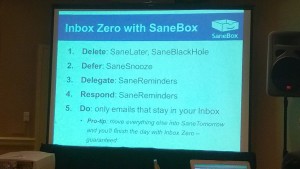ILTA 2014 – Nashville 18th-21st August
One of the hardest things I find to do for ILTA is to plan your week, when I attended in 2010 I had a wingman and so we could split the sessions between us. As the only rep from our firm this side of the pond it was difficult to fit everything in. I typically had between two and four sessions I was interested in per slot, inevitably in some sessions I found myself wishing I was elsewhere (going by the tweets from the other sessions). For some of these I missed I can of course catch up through the recordings, but for others (the vendor roadmaps in particular) I couldn’t as they weren’t recorded (why do vendors do this?!?).
Monday’s sessions
The first session I attended on Monday was entitled “Do collaborative spaces ever work (INFO1)”, this a panel session format where the question posed was “Social networking/collaborative spaces within a firm are a dangerous distraction from doing real work?” Two of the panelists took opposing sides to this question whilst the other moderated.
To be fair I think the panellist arguing for this question was struggling and in the end they all pulled together five points each on how to make a success. Some points overlapped and so below is my mash-up of them all:
- Get business requirements. Find who will use it, what information they want to share and why they want to share it.
- Get people using it. Difficulty here though as people will go to where the content is, but if you can’t get the people there then there will be no content. Catch 22!
- Don’t make people fit technology. If doesn’t feel natural people won’t use, IT get excited by tech, on average lawyers don’t.
- Another Catch 22 from the panellists. Don’t try and do it all at once, life is a game of inches. But you also need to go big and lean in because you have to get enough content and people in there to start with.
- Keep it simple
- Lead by example. Have community leaders. Seed content, nurture discussion, moderate if required.
Overall this was a good discussion and I came away with some thoughts on recent projects and future collaboration platforms.
Next up was “Here, Now & Beyond law 2020 (SPEC2)”. This was a talk of two halves, first some really interesting discussion on how Pillsbury had moved their global operations centre and its services to Nashville. Improving the service function to support the lawyers. They are now looking at a second phase, focussing on the lawyers. Bringing lawyers into the centre. eDiscovery, case support, Lit support etc. They talked about the choices they made and cost savings, overall labour savings were the biggest saving, far above the location cost savings in a cheaper city. The whole concept of service was worked on by Pillsbury, they introduced consistency across all services, not just IT. Working on consistency in service process, in reporting and in rewarding staff. They also tried to ensure the people in Nashville felt part of the firm and not just an outsourced offshoot, this was critical to the success.
The rest of the session was talk about information governance, cyber security and project management as well as the centralisation but I didn’t find this as interesting so didn’t take that many notes unfortunately.
After lunch was “Predictive analytics: email management magic? (APP3)” where a panel of four talked about using analytics and predictive technologies and how they can be used in email filing. It was really four firms explaining how their technology/approach helps with the two email filing issues: Tackling the huge backlog and then the ongoing day to day filing. The gist of the solutions though was that they were usually hitting an 80-85% accuracy, I couldn’t help think that this was similar to the stats for speech recognition in the early 2000’s and a big blocker to adoption. Still I came away with a great quote one of the panelists used; “You know in the movies where the zombies break through and keep coming through the windows, that’s my email”.
The final session was entitled “Top 10 Tablet Tasks Talked Through Thoroughly – (APP17)”, where three panelists took you through the best 10 apps for iOS, Android and Windows. Unfortunately I didn’t come away with much new. The iOS list I knew, the Android was pretty much the same and the Windows tablet was a Surface 3 and so ran pretty much everything!
Tuesday’s sessions
First up was pretty much a vendor demo “SaneBox To Outsmart Your Inbox (SPOT3)”, this was a nice email management tool. It’s aim is to address the issue they’ve highlighted in a study that shows 30% of our time is spent “doing email” and not doing the jobs in our job description. And of this 40% email is useful to 60% being just noise! Simply SaneBox is a server side email tool (the integration with exchange, for example, is lightweight. Basically it requests the header, analyses it and then does a lightweight folder move request). From the user end it creates a number of folders to quickly sort and manage your emails. The picture below shows some of the basic ones:
The aim of the product is to achieve inbox zero by the end of the day and help organise your email to ensure its easy to action. It’s worth having a look on their website for full information on how it works. I came away thinking it would be pretty good if you get stressed by a full Inbox. For Legal ITers the question of what about all the Legal Outlook Addins was asked! The answer wasn’t conclusive but an explanation of the architecture made you think it ‘should’ ensure it doesn’t clash with any of them.
Next up was “Decision Factors for Windows 8/8.1 (DASPG4)” looking at a number of firms who have done a Windows 8 rollout and some of the challenges they faced.
- Most rolled out Surfaces – still unsure how they justified the cost of these machines over a sub £700 laptop.
- For those going from Windows 7 and Office 2010 the transition from a technical perspective was fairly straightforward. One comment from a company going from Office 2003 was that going to Office 2013 was more difficult than the transition to Windows 8.
- There was positive feedback from the end users for speed and stability.
- Challenge was how to deal with the appstore. How to enrol people, firm wide or individually? Most turned off as not many legal it vendors delivering “metro apps” and so not that crucial at the moment.
- Metro v Desktop? Example firm split 50-50 of tiles v traditional view in a pilot, after the pilot most people wanted to stick with metro (even from those starting from the desktop traditional view)
There was a question at the end, “we’re probably looking to upgrade in the next six to nine months should we wait for Windows 9?” Answer: “No”. The feeling was that getting your applications tested and integrated now was best as you’ll get a head start. Also mentioned was the need to think about the wait for vendor support in going with version 9, it was 6-9 months post Windows 8 in terms of lead time so could be waiting 12months+ from when Windows 9 is launched before you could rollout.
Last up was “DMS in the cloud (ETPG3)” which really should have been intranet in the cloud. It was more about how Microsoft transferred their internal SharePoint intranet site for their in-house legal onto Office365, interesting but not quite what I was expecting. There was mention of how this programme helped develop Microsoft’s Matter Centre for Office365 which launched at ILTA 2014 but I’ll talk about that in a separate post.
In the next post on Thursday I’ll wrap up the sessions for the Wednesday and Thursday mornings and cover off the keynotes from Tuesday and Wednesday (I skipped Thursdays to fit in some chats to vendors and packing for the flight home!)




RT @planty: [blog] Across the pond to ILTA 2014 – a retrospective look part two : http://t.co/vzEL6p3wQc #LegalIT #ILTA2014
RT @planty: [blog] Across the pond to ILTA 2014 – a retrospective look part two : http://t.co/vzEL6p3wQc #LegalIT #ILTA2014
RT @planty: [blog] Across the pond to ILTA 2014 – a retrospective look part two : http://t.co/vzEL6p3wQc #LegalIT #ILTA2014